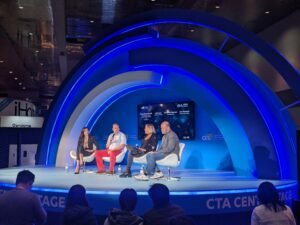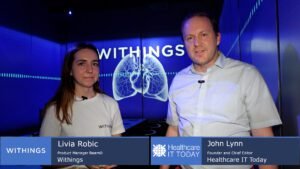CES is always a fun show for a tech guy like myself. With 130,000 people, there’s a lot of noise that doesn’t relate to healthcare IT, but over the years the digital health portion of CES has really grown. This year that growth was particularly true thanks to the great efforts of Catherine Pugh who put together an entire Digital Health track, a long list of digital health vendors, and a packed house digital health networking event.
While I’m sure I missed plenty of the digital health happenings at CES, here’s a quick rundown of some of the things I found interesting.
Digital Health Media Panel at CES 2024
First up was a fun Digital Health media panel that I participated in on the CTA Center Stage with Eric Wicklund, Content Specialist at HealthLeaders Media, Savannah Peterson, Host at theCUBE, and Grace Venes-Escaffi, Sr. Coordinator, CES & Industry Communications at CTA as moderator.
If you missed it, you can listen to our Digital Health panel on Spotify which is part of the CES Tech Talk podcast.
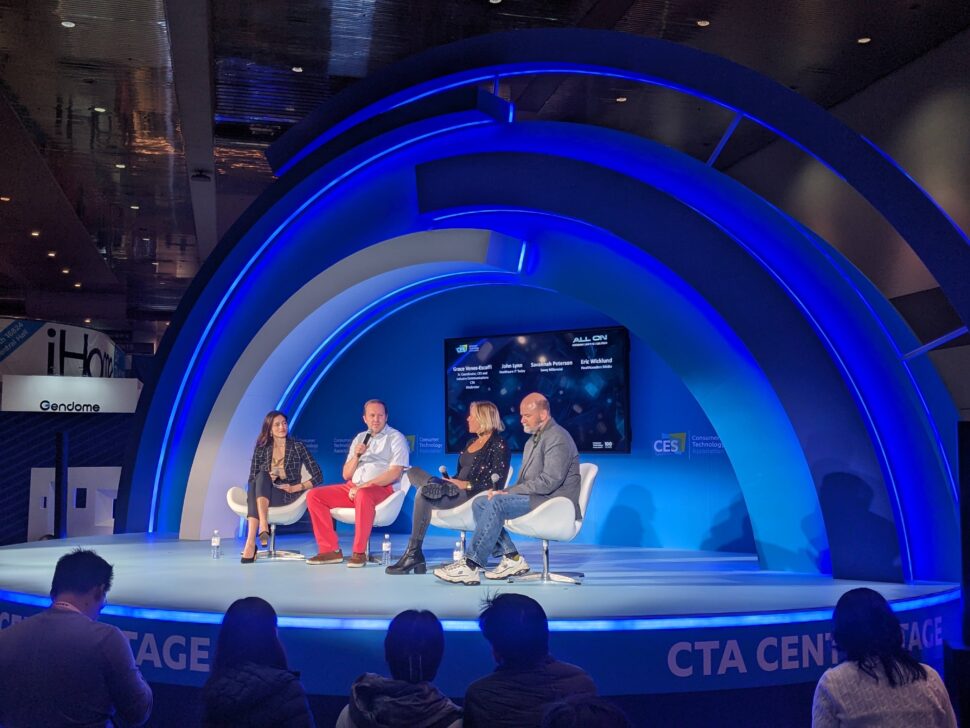
Informed Medical – Video Vital Signs
One of the coolest things I see happening with remote patient monitoring and measuring people’s vital signs is what I call invisibles. Sure, wearables are great, but it’s much better if a person’s vital signs is just collected automatically. Some of us don’t really want to wear a watch or ring. Not to mention charging, etc.
We’ve covered technologies like this before like NuraLogix, but I was really impressed by what I saw from Informed Medical that I was introduced to in the LG booth. They have a medical device background, so they’re really approaching this as a medical device. They are still waiting on FDA clearance (like most in this space), but the concept is so simple and beautiful.
Turns out that a video camera can see the blood flow in your skin (my simplified version of what’s really happening). From that blood flow you can measure a person’s heart rate, blood pressure, breathing rate, and blood oxygen. At least that’s the potential and what they’re working to verify. Of course, these companies can’t say this is what they’re able to do until they get FDA clearance, but the early results seem promising.
Here’s a look at how their demo worked for me. I sat down in front of the cell phone. They tell me the light isn’t totally necessary, but most of their AI models had been done in good light and so that’s why they used it for this demo. They plan to refine this over time as they have more data.
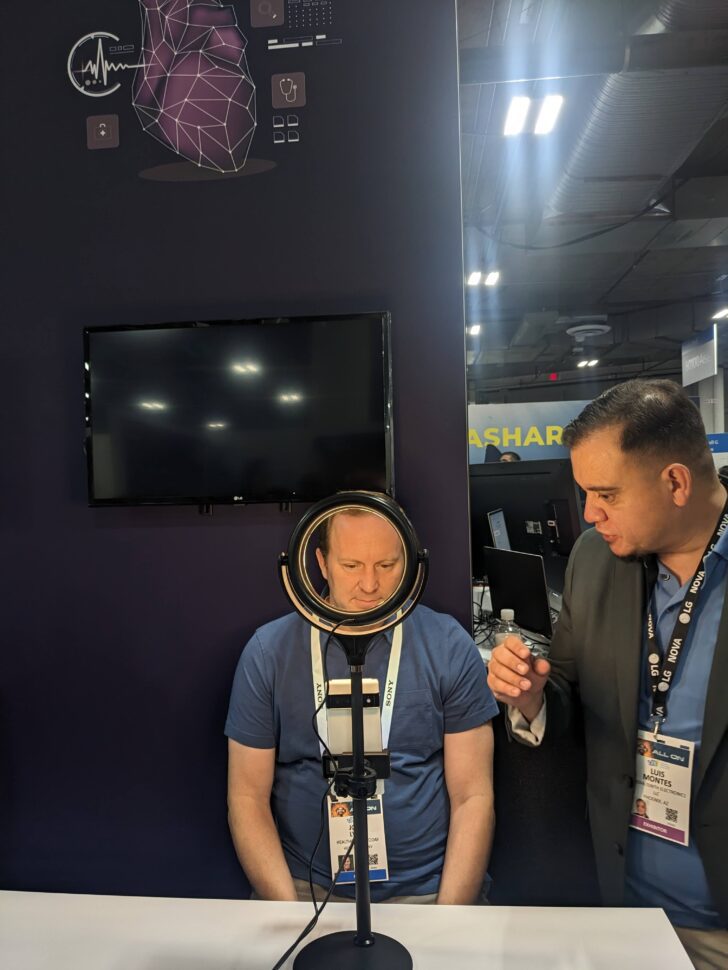
You’ll see that for this demo application I just have to center my face in the circle for about 60 seconds or so and the Informed tool analyzes all 4 vital signs. It was interesting to try and hold still for this. Also, they were showing a real time feed of the 4 results based on what it was able to assess which I assume probably won’t be in the final product, but was fascinating to watch.
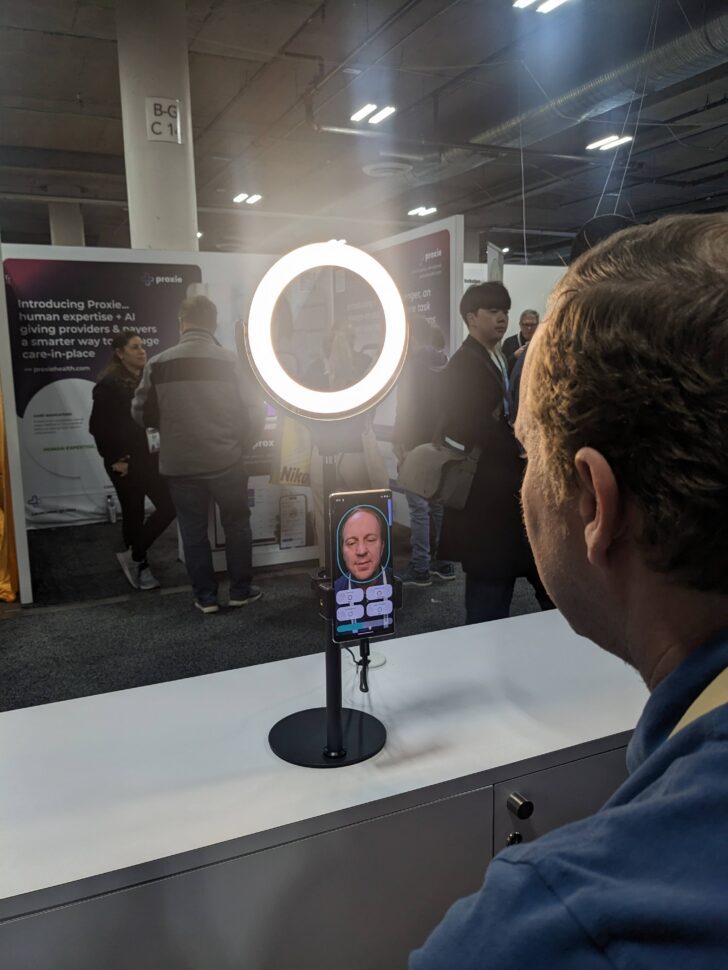
Finally, it showed me my completed test results. They said that they felt pretty solid on the heart rate and blood pressure was coming along. The breathing rate and oxygen saturation was still something they were working to refine and needed more data to ensure its accuracy. I wish I’d had a ring or watch on to compare data, but I didn’t at the time.
It’s also worth noting that what you see below is just a basic demo application. Informed likely won’t be the one creating the application they use. Instead, they’ll license their technology to other digital health applications that want to incorporate this data into their use cases.
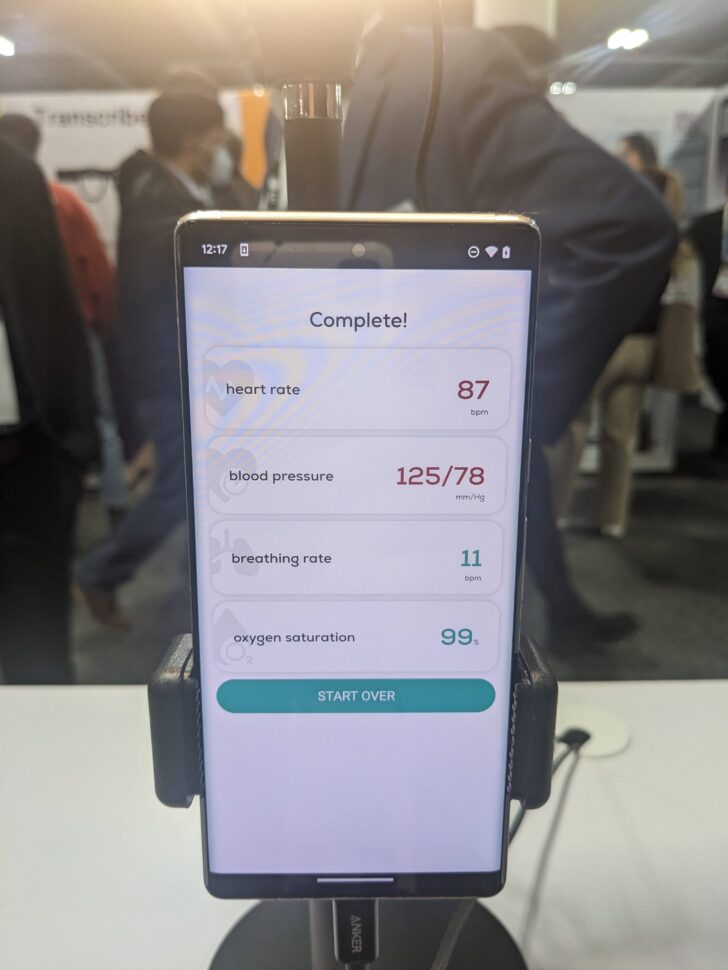
It’s not hard to see how these video vital signs are going to be a great way to remotely monitor a patient. I’m excited for these applications to clear the FDA process so that doctors and medical providers will trust them and can start using them.
MVITRO No Prick Glucose Monitor
One of the coolest things I saw at CES in the health space was the Blood Glucose Monitor from MVITRO. I’ll admit that this is really a medical device which we don’t cover much on this site (and it not often found at CES), but considering I literally gave blood to test out the MVITRO product, I figured I’d share it.
The MVITRO device uses a laser instead of a needle prick to draw blood to test your glucose levels. As you’ll see in the video below, the laser didn’t hurt at all. You literally hear me say, it just felt like someone was touching me. Then, you see how they’re able to get the blood and do the regular test of your blood sugar using test strips and the laser device. What’s even more interesting is that he just wiped the site off, but there was no need for a bandaid or anything. The site did feel slightly off for a few minutes after, but it was essentially painless. They told me that with this device you can use the same finger and it doesn’t build up the same scar tissue that a prick does. I remember my grandfather who had diabetes for 30 years looking at his fingers to decide which one he should use because of all the built up scar tissue.
Check out this video to see the MVITRO in action:
After they did the laser “prick” (if you will), they asked everyone to put a sticker on this chart to describe how the laser experience felt. It’s a pretty compelling sign. They might need to submit it for a Swaay.Health Marketing Award.
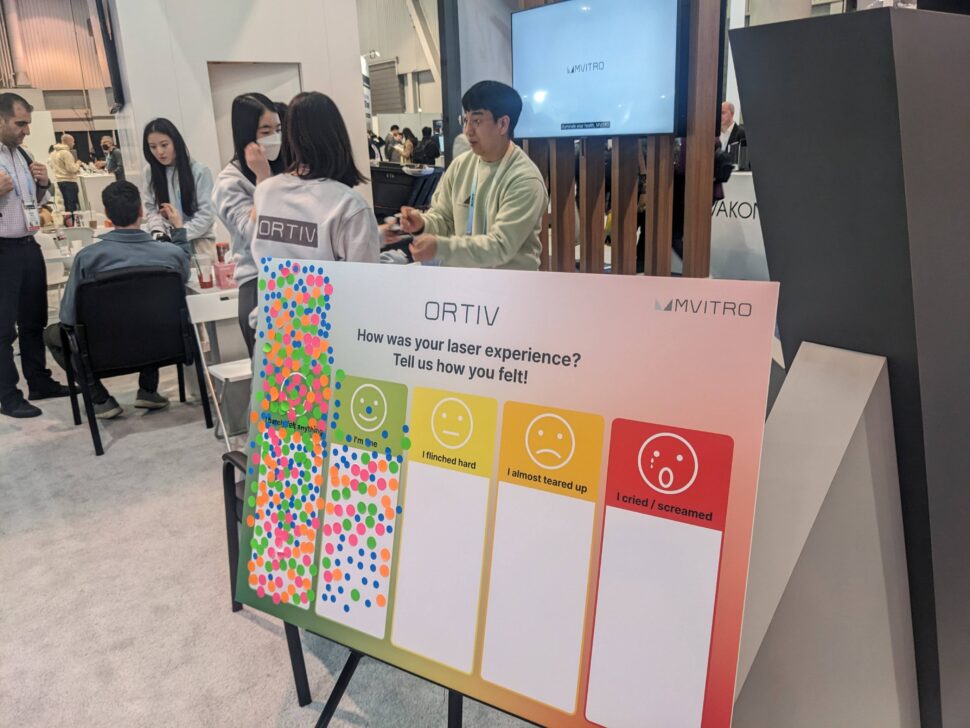
I heard that someone at CES was working on a glucose monitor that didn’t require blood. I didn’t see it though, so I’m not sure how that works and where it’s at in the process of FDA approval, etc.
C.Light Technologies – Alzheimers, Concussions, and More
I was really impressed with a company called C.Light Technologies that was also at the LG booth. I’ll admit that the work they’re doing is way beyond me and needs a doctor to evaluate it properly. However, the base concept is pretty simple and seems to show a lot of promise. Your eye movement is a reflection of your brain. The C.Light Technologies (as you see below) analyzes your eye movement to help evaluate your brain health.
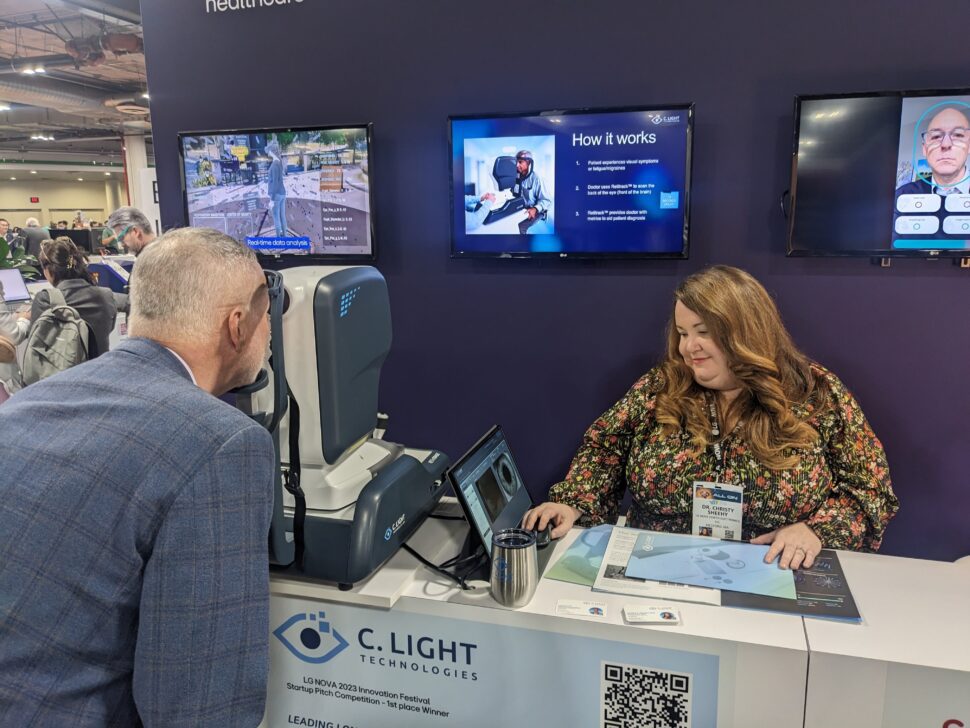
C.Light Technologies is still in the early stages of taking this product from concept to FDA approval, but they’re well on their way to that in a few areas. Some of the areas they’re looking at using this eye movement for is Alzheimer’s, concussions, and retinal diseases. I love their novel approach to analyzing eye movement to be able to address various neurodegenerative diseases, neuroinflammatory diseases, brain injuries, concussions, and retinal diseases. They tell me they’re working on a smaller form factor than what’s pictured above too.
Like I said, I’m not a doctor and so I’ll the medical professionals do the deep dive into this technology. Plus, C.Light Technologies is working on the proper FDA approval and clinical studies to validate their device, but it seemed to show a lot of promise.
M2 Test – Bone Density Testing
I’ll admit that M2 Test was most interesting to me because they were from Italia (Italy). Every year there’s a section of CES that includes companies from Italy. Anyone that knows me knows that I love Italy, so I go over there asking if they have any digital health companies. Plus, it looks like I’m going to take part in HIMSS Europe 2024 in Rome this year (Let me know if you’d like to do some paid videos at the event so Colin is glad I’m there) and so I wanted to meet more digital health companies from Italy.
My Italian bias aside, what M2 Test is doing is pretty interesting. They’re using some standard radiology reads and using their AI solution to evaluate bone density. Considering the number of fractures that happen, you can see how this can be a valuable tool. Plus, it’s important to remember that there are a lot of factors that can hurt or help bone density which changes over time. Tracking it and knowing what is helping and what is hurting is really interesting. Again, I’m not a doctor, but it was interesting to see M2 Test working on this important problem.
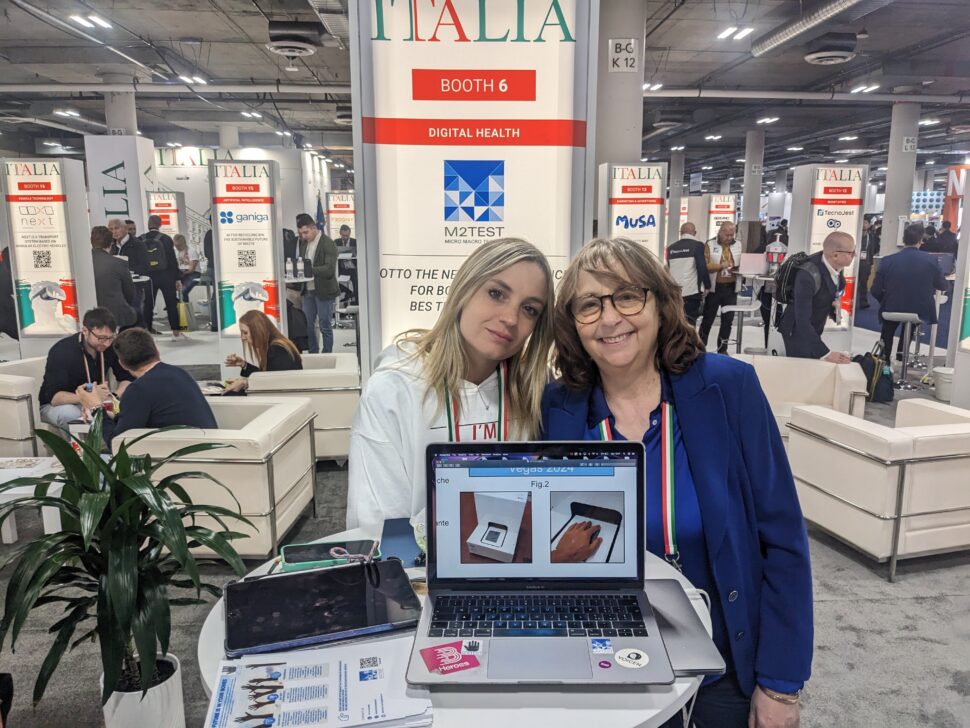
RingConn Smart Ring
One of the busiest booths in the Digital Health space at CES 2024 was the RingConn booth. I won’t dive into too many details here, since they gave me one to try out. Once I’ve had time to use it for a bit, I’ll share a full demo of the RingConn smart ring in a future article. I will say it’s a pretty stylish ring and I love the battery life too. More details to come.
Withings BeamO – Multi-use Health Monitoring Device
The Withings BeamO was also another big hit at CES 2024. I actually did a full video interview with the Withings team in a really cool space they’d created to share the new product. The picture below just gives you a small look at the space. Watch for the full video interview about the Withings BeamO coming soon.
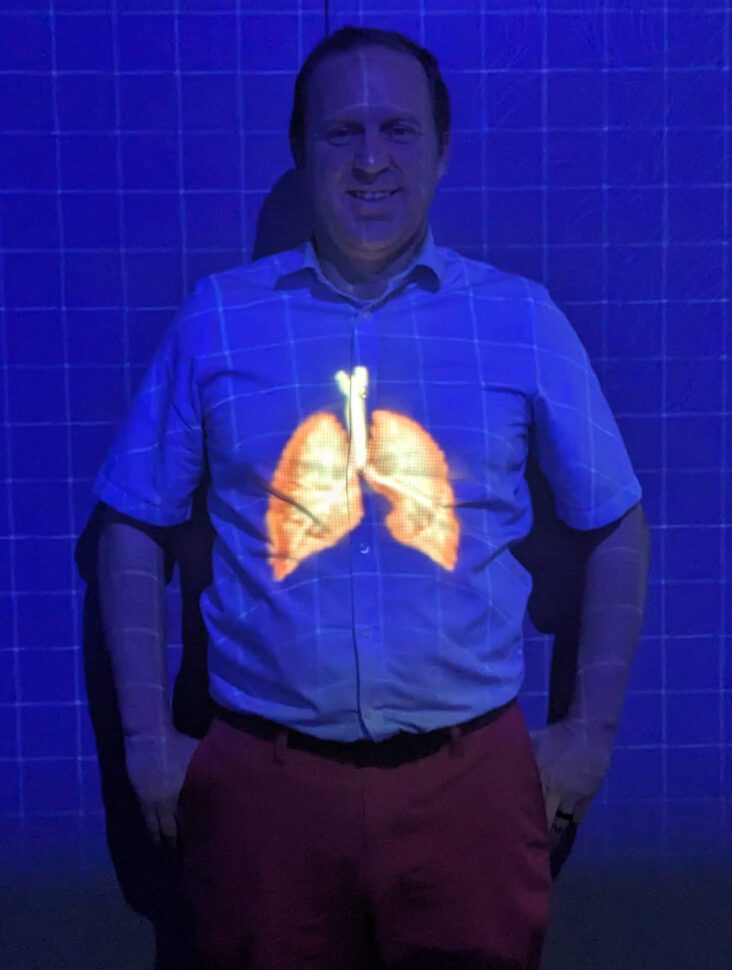
What did you see or hear about when it comes to Digital Health at CES 2024? What did I miss that I’m going to have FOMO for not seeing it? Let us know in the comments or on social media.
Get Fresh Healthcare & IT Stories Delivered Daily
Join thousands of your healthcare & HealthIT peers who subscribe to our daily newsletter.
